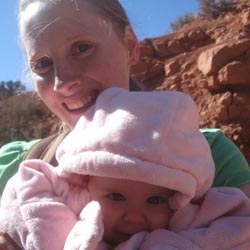


Hype:
Conglomerate Canyons is a fun off-trail hike through two rarely-visited washes. One canyon has a large conglomerate cliff, and the other has a conglomerate boulder field.
Trail Condition: Class 2 (Trail may have tree roots or rocks jutting out. Navigation skills may consist of following rock cairns and choosing turns at junctions. Elevation gains may be more substantial.)
Time: 2 hours
Length: 2.1 miles round trip
Elevation Gain: 390 ft
Fees: None
Recommended Ages:
 | 0-3 |
 | 4-11 |
 | 12-19 |
 | 20-49 |
 | 50-69 |
 | 70+ |
Recommended Months to Visit:
| Jan |
| Feb |
| Mar |
| Apr |
| May |
| Jun |
| Jul |
| Aug |
| Sep |
| Oct |
| Nov |
| Dec |
Navigate to 38.788906, -112.098755.
By Jeremy Dye
Jeremy Dye, Tara Dye, Savannah Dye,
These two canyons are named after a large conglomerate cliff in the second right-hand tributary to Cottonwood Creek and a large conglomerate boulder field in the third right-hand tributary to Cottonwood Creek. A coworker recommended these canyons to us.
We drove as far as we dared (2WD on a muddy road) then pulled over and parked on the side of the road.
We soon came across three lime kilns. These lime kilns were made in the late 1800s. A nearby monument explains the history of the kilns:
This old lime kiln is the best preserved of seven kilns constructed north of Richfield during the late 1800s. It was built by John Kyhl for Jens Larson Jensen, a Swedish immigrant. The lime was used in the construction of homes, churches, and schools of the early settlers. Limestone was quarried in the nearby hills, melted down in the kilns, and cooled - a process that took several days. The result was a fine, white lime powder suitable for brick making, mortar, and plaster. Use of this kiln ended around 1905, when Mr. Jensen went blind from exposure to the extreme heat.National Society of the Sons of Utah Pioneers
We then headed up the second right-hand tributary to Cottonwood Creek.
After about 20 minutes, we reached a large conglomerate cliff. After a storm, this would be an impressive waterfall.
After about 45 minutes, we exited the second right-hand tributary, hiked over the ridge to the north, and dropped into the third right-hand tributary.
Near the bottom of the third right-hand tributary, we came across an awesome boulder field of conglomerate rock.
We got back to the car around 2:10, which made for a round trip time of about an hour and a half.
Monroe Canyon First Lefthand Fork Primitive Camping 1
Monroe Canyon First Lefthand Fork Primitive Camping 2
Oak Creek Recreation Site / Campground
Sheep Valley Primitive Camping
Upper Box Creek Reservoir Camping
Loop Hike from Puffer Lake around Lake Peak
Paddling Upper Box Creek Reservoir